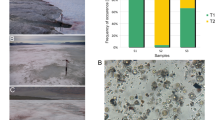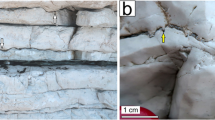Abstract
KEROGEN is an inert amorphous organic material insoluble in organic solvents, mineral acids, and bases1. In spite of its abundance, the precise molecular structure of this insoluble organic material has long remained an enigma. Structural determinations are complicated by the fact that the structure of any kerogen from different samples varies depending on the types of organic material originally responsible for its formation, and variations in the environmental conditions experienced during and after its formation. We have shown that kerogen-like material can be isolated from recently deposited algal mats. On oxidative degradation this material gives rise to products similar in nature to those obtained by degradation of ancient kerogens known to be of algal origin2,3. These results imply that kerogen-like precursors or proto-kerogens, are formed very rapidly on a geological time scale and are found in certain types of recent sediments rich in organic matter.
This is a preview of subscription content, access via your institution
Access options
Subscribe to this journal
Receive 51 print issues and online access
$199.00 per year
only $3.90 per issue
Buy this article
- Purchase on Springer Link
- Instant access to full article PDF
Prices may be subject to local taxes which are calculated during checkout
Similar content being viewed by others
References
Robinson, W. E., in Organic Geochemistry: Methods and Results (edit. by Eglinton, G., and Murphy, M.), 181–193 (Springer, Berlin, 1968).
Philp, R. P., and Calvin, M., in Proc. second Int. Symp. environ. Biogeochem. (edit. by Nriagu, J.), 131–148 (Ann Arbor, Michigan, 1976).
Philp, R. P., and Calvin, M., in Advances in Organic Geochemistry, 1975 (in the press).
Bradley, W. H., Geol. Soc. Am. Bull., 84, 1121–1124 (1973).
Simoneit, B. R., and Burlingame, A. L., Geochim. cosmochim Acta, 37, 595–610 (1973).
Forsman, J. P., in Organic Geochemistry (edit. by Breger, I. A.), 148–162 (Pergamon, Oxford, 1963).
Tissot, B., Durand, B., Espitalie, J., and Combaz, A., Am. Assoc. Petrol. Geol. Bull., 58, 499–506 (1974).
Djuricic, M. V., et al., in Advances in Organic Geochemistry, 1971 (edit. by von Gaertner, H. R., and Wehner, H.), 305–321 (Pergamon, Oxford, 1972).
Burlingame, A. L., and Simoneit, B. R., Nature, 222, 741–747 (1969).
Van der Berg, M. L. J., de Leeuw, J. W., and Schenck, P. A., in Advances in Organic Geochemistry, 1973 (edit. by Tissot, B., and Bienner, F.), 180–189 (Editions Technip, Paris, 1974).
Lawlor, D. L., Fester, J. I., and Robinson, W. E., Fuel, 42, 239–244 (1963).
Gallegos, E. J., Analyt. Chem., 47, 1524–1528 (1975).
Han, J., McCarthy, E. D., Van Hoeven, W., Calvin, M., and Bradley, W. H., Proc. natn. Acad. Sci. U.S.A., 59, 29–33 (1968).
Han, J., McCarthy, E. D., Calvin, M., and Benn, M. H., J. chem. Soc., C, 2785–2791 (1968).
Ogner, G., Acta chem. scand., 27, 1601–1612 (1973).
Dunn, J. H., and Wolk, P. C., J. Bact., 103, 153–158 (1970).
Oehler, J. H., Aizenshtat, Z., and Schopf, J. W., Am. Ass. petrol. Geol. Bull., 58, 124–132 (1974).
Burlingame, A. L., and Simoneit, B. R., in Advances in Organic Geochemistry, 1973 (edit. by Tissot, B., and Bienner, F.), 191–201 (Editions Technip, Paris, 1974).
Author information
Authors and Affiliations
Rights and permissions
About this article
Cite this article
PHILP, R., CALVIN, M. Possible origin for insoluble organic (kerogen) debris in sediments from insoluble cell-wall materials of algae and bacteria. Nature 262, 134–136 (1976). https://doi.org/10.1038/262134a0
Received:
Accepted:
Published:
Issue Date:
DOI: https://doi.org/10.1038/262134a0
This article is cited by
-
Sorption and transformation of biocides from hydraulic fracturing in the Marcellus Shale: a review
Environmental Chemistry Letters (2022)
Comments
By submitting a comment you agree to abide by our Terms and Community Guidelines. If you find something abusive or that does not comply with our terms or guidelines please flag it as inappropriate.



